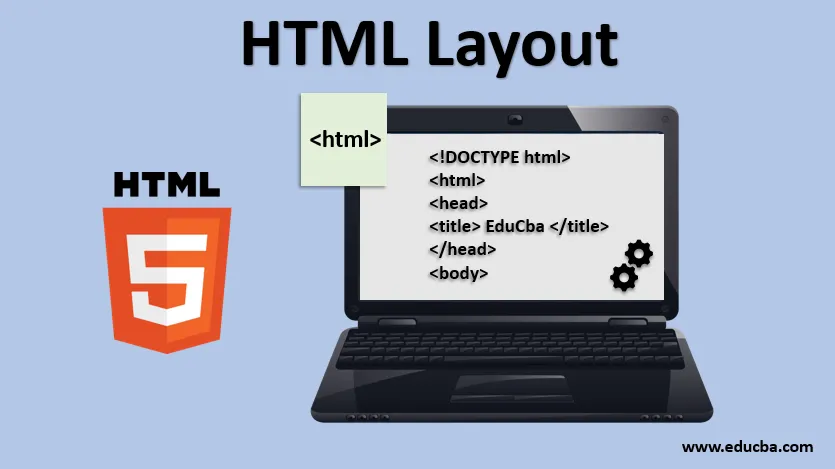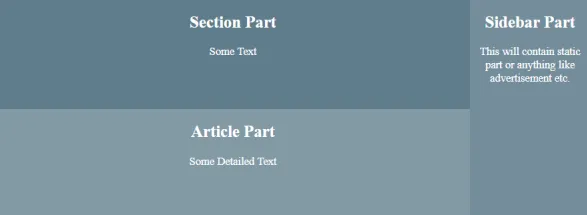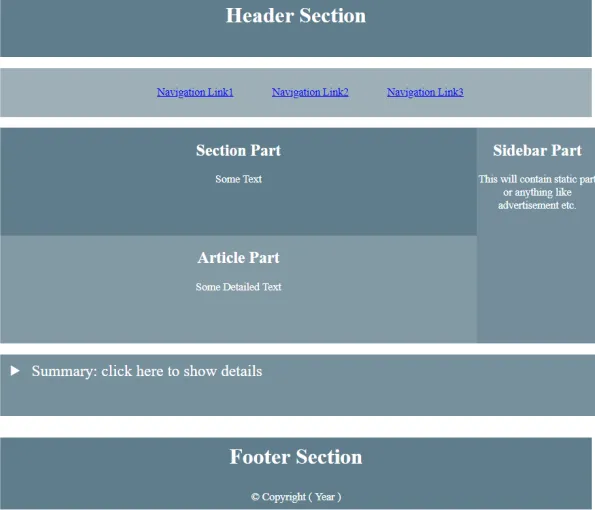
Introdução ao layout HTML
Ao projetar uma página da Web, é importante organizar os elementos da página da Web de maneira elegante. Eles devem ser fáceis de navegar para o usuário e simples. O layout HTML fornece uma maneira de organizar esses elementos de maneira bem estruturada. O layout HTML dá uma boa aparência à página da web e também oferece uma maneira fácil de projetar. O layout HTML é uma maneira simples de projetar elementos da Web usando tags HTML padrão simples. O HTML oferece vários elementos de layout, usando os quais podemos projetar várias partes da página da web.
Elementos de layout HTML
Neste artigo, veremos diferentes elementos de layout HTML, juntamente com seus exemplos. Vamos projetar uma estrutura simples semelhante ao jornal usando esses elementos.
1
Este elemento é usado para definir o cabeçalho da página da web. Ele contém o título da página ou algum logotipo ou talvez um conteúdo introdutório.
Código :
EduCba
Header Section
EduCba
Header Section
EduCba
Header Section
Saída :

2)
Este elemento conterá links para a lista de menus. Este elemento é como um contêiner para diferentes links de navegação. Os links estarão em uma página diferente ou na mesma página.
Código :
Vamos adicionar um elemento de navegação logo abaixo do cabeçalho do nosso último exemplo. Adicione parte ao elemento e parte logo abaixo da seção do cabeçalho.
li(
display: inline-flex;
padding: 25px
)
ul(
text-align: center;
)
Navigation Link1
Navigation Link2
Navigation Link3
li(
display: inline-flex;
padding: 25px
)
ul(
text-align: center;
)
Navigation Link1
Navigation Link2
Navigation Link3
li(
display: inline-flex;
padding: 25px
)
ul(
text-align: center;
)
Navigation Link1
Navigation Link2
Navigation Link3
li(
display: inline-flex;
padding: 25px
)
ul(
text-align: center;
)
Navigation Link1
Navigation Link2
Navigation Link3
li(
display: inline-flex;
padding: 25px
)
ul(
text-align: center;
)
Navigation Link1
Navigation Link2
Navigation Link3
li(
display: inline-flex;
padding: 25px
)
ul(
text-align: center;
)
Navigation Link1
Navigation Link2
Navigation Link3
li(
display: inline-flex;
padding: 25px
)
ul(
text-align: center;
)
Navigation Link1
Navigation Link2
Navigation Link3
li(
display: inline-flex;
padding: 25px
)
ul(
text-align: center;
)
Navigation Link1
Navigation Link2
Navigation Link3
li(
display: inline-flex;
padding: 25px
)
ul(
text-align: center;
)
Navigation Link1
Navigation Link2
Navigation Link3
Saída :

3)
Este elemento é como a seção principal da página da web. Pode conter qualquer tipo de informação. Pode conter texto, imagens, etc.
4)
Como o nome sugere, esse elemento conterá conteúdo como um parágrafo, qualquer descrição detalhada de algo ou qualquer tipo de informação. Geralmente, esta será a parte principal que contém informações em uma página da web.
5)
Este elemento definirá o conteúdo que ficará ao lado do conteúdo principal, como seção ou artigo. Esse elemento de informação é opcional e geralmente contém informações adicionais ou conteúdo de anúncio.
Código :
Vamos adicionar todos esses três elementos juntos abaixo da barra de navegação.
li ( display: inline-flex;
padding: 25px
)
section(
background-color: #607D8B;
width: 79%;
position: absolute;
height: 150px;
)
article(
width: 79%;
background-color: #607d8b70;
position: absolute;
top: 368px;
height: 150px;
)
aside(
background-color: #607d8b99;
width: 20%;
position: absolute;
left: 80%;
height: 300px;
)
h2, p (
text-align: center;
color: #9c27b0;
)
ul(
text-align: center;
)
Section Part
li ( display: inline-flex;
padding: 25px
)
section(
background-color: #607D8B;
width: 79%;
position: absolute;
height: 150px;
)
article(
width: 79%;
background-color: #607d8b70;
position: absolute;
top: 368px;
height: 150px;
)
aside(
background-color: #607d8b99;
width: 20%;
position: absolute;
left: 80%;
height: 300px;
)
h2, p (
text-align: center;
color: #9c27b0;
)
ul(
text-align: center;
)
Section Part
li ( display: inline-flex;
padding: 25px
)
section(
background-color: #607D8B;
width: 79%;
position: absolute;
height: 150px;
)
article(
width: 79%;
background-color: #607d8b70;
position: absolute;
top: 368px;
height: 150px;
)
aside(
background-color: #607d8b99;
width: 20%;
position: absolute;
left: 80%;
height: 300px;
)
h2, p (
text-align: center;
color: #9c27b0;
)
ul(
text-align: center;
)
Section Part
li ( display: inline-flex;
padding: 25px
)
section(
background-color: #607D8B;
width: 79%;
position: absolute;
height: 150px;
)
article(
width: 79%;
background-color: #607d8b70;
position: absolute;
top: 368px;
height: 150px;
)
aside(
background-color: #607d8b99;
width: 20%;
position: absolute;
left: 80%;
height: 300px;
)
h2, p (
text-align: center;
color: #9c27b0;
)
ul(
text-align: center;
)
Section Part
Algum texto
Artigo Parte
Algum texto detalhado
Parte da barra lateral
Isso conterá parte estática ou qualquer coisa como propaganda etc.
Saída :

6
Este elemento é usado para exibir detalhes adicionais sobre a página da web para o usuário. Isso pode conter informações adicionais opcionais para o usuário. Esse elemento por padrão fornece um recurso para mostrar ou ocultar detalhes ao clicar.
7)
Este elemento é usado junto com o elemento As informações que serão ocultadas e mostradas ao clicar estarão nesta tag. Este elemento estará dentro do elemento de detalhes.
Código :
Vamos adicionar elementos de detalhes junto com o elemento de resumo em nosso exemplo existente. Basta adicionar o código abaixo após as partes do item, seção e artigo na tag.
Summary: click here to show details
Detalhes: Ao clicar no elemento de resumo, os detalhes serão mostrados ao usuário
detalhes (
margem superior: 330 px;
largura: 100%;
padding-top: 10px;
fundo do preenchimento: 50px;
preenchimento esquerdo: 15 px;
cor de fundo: # 607d8bdb;
)
detalhes p (
tamanho da fonte: 18 px;
)
resumo (
cor branca;
tamanho da fonte: 22 px;
)
Saída1 : sem clicar no elemento de detalhes.

Saída2: Após clicar no elemento de detalhes.

8)
Para cada página da web, haverá uma seção na parte inferior da página, conhecida como rodapé. Este elemento é usado para definir a seção de rodapé na parte inferior da página da web. A seção de rodapé geralmente contém informações como direitos autorais, ano, informações de contato etc. É uma prática padrão ter um rodapé nas páginas da Web e ele estará na parte inferior de uma página da Web.
Código :
Vamos adicionar rodapé em nossa página da web na parte inferior.
Footer Section
Footer Section
Footer Section
Footer Section
© Copyright (Ano)
Saída :

Portanto, nosso código final e sua saída serão assim,
Código:
EduCba
li( display: inline-flex;
padding: 25px
)
section(
background-color: #607D8B;
width: 79%;
position: absolute;
height: 150px;
)
article(
width: 79%;
background-color: #607d8bc7;
position: absolute;
top: 368px;
height: 150px;
)
aside(
background-color: #607d8bde;
width: 20%;
position: absolute;
left: 80%;
height: 300px;
)
h2, p (
text-align: center;
color: #fff;
)
ul(
text-align: center;
)
details (
margin-top: 330px;
width: 100%;
padding-top: 10px;
padding-bottom: 50px;
padding-left: 15px;
background-color: #607d8bdb;
)
details p (
font-size: 18px;
)
summary (
color: white;
font-size: 22px;
)
Header Section
Navigation Link1
Navigation Link2
Navigation Link3
Section Part
EduCba
li( display: inline-flex;
padding: 25px
)
section(
background-color: #607D8B;
width: 79%;
position: absolute;
height: 150px;
)
article(
width: 79%;
background-color: #607d8bc7;
position: absolute;
top: 368px;
height: 150px;
)
aside(
background-color: #607d8bde;
width: 20%;
position: absolute;
left: 80%;
height: 300px;
)
h2, p (
text-align: center;
color: #fff;
)
ul(
text-align: center;
)
details (
margin-top: 330px;
width: 100%;
padding-top: 10px;
padding-bottom: 50px;
padding-left: 15px;
background-color: #607d8bdb;
)
details p (
font-size: 18px;
)
summary (
color: white;
font-size: 22px;
)
Header Section
Navigation Link1
Navigation Link2
Navigation Link3
Section Part
EduCba
li( display: inline-flex;
padding: 25px
)
section(
background-color: #607D8B;
width: 79%;
position: absolute;
height: 150px;
)
article(
width: 79%;
background-color: #607d8bc7;
position: absolute;
top: 368px;
height: 150px;
)
aside(
background-color: #607d8bde;
width: 20%;
position: absolute;
left: 80%;
height: 300px;
)
h2, p (
text-align: center;
color: #fff;
)
ul(
text-align: center;
)
details (
margin-top: 330px;
width: 100%;
padding-top: 10px;
padding-bottom: 50px;
padding-left: 15px;
background-color: #607d8bdb;
)
details p (
font-size: 18px;
)
summary (
color: white;
font-size: 22px;
)
Header Section
Navigation Link1
Navigation Link2
Navigation Link3
Section Part
EduCba
li( display: inline-flex;
padding: 25px
)
section(
background-color: #607D8B;
width: 79%;
position: absolute;
height: 150px;
)
article(
width: 79%;
background-color: #607d8bc7;
position: absolute;
top: 368px;
height: 150px;
)
aside(
background-color: #607d8bde;
width: 20%;
position: absolute;
left: 80%;
height: 300px;
)
h2, p (
text-align: center;
color: #fff;
)
ul(
text-align: center;
)
details (
margin-top: 330px;
width: 100%;
padding-top: 10px;
padding-bottom: 50px;
padding-left: 15px;
background-color: #607d8bdb;
)
details p (
font-size: 18px;
)
summary (
color: white;
font-size: 22px;
)
Header Section
Navigation Link1
Navigation Link2
Navigation Link3
Section Part
EduCba
li( display: inline-flex;
padding: 25px
)
section(
background-color: #607D8B;
width: 79%;
position: absolute;
height: 150px;
)
article(
width: 79%;
background-color: #607d8bc7;
position: absolute;
top: 368px;
height: 150px;
)
aside(
background-color: #607d8bde;
width: 20%;
position: absolute;
left: 80%;
height: 300px;
)
h2, p (
text-align: center;
color: #fff;
)
ul(
text-align: center;
)
details (
margin-top: 330px;
width: 100%;
padding-top: 10px;
padding-bottom: 50px;
padding-left: 15px;
background-color: #607d8bdb;
)
details p (
font-size: 18px;
)
summary (
color: white;
font-size: 22px;
)
Header Section
Navigation Link1
Navigation Link2
Navigation Link3
Section Part
EduCba
li( display: inline-flex;
padding: 25px
)
section(
background-color: #607D8B;
width: 79%;
position: absolute;
height: 150px;
)
article(
width: 79%;
background-color: #607d8bc7;
position: absolute;
top: 368px;
height: 150px;
)
aside(
background-color: #607d8bde;
width: 20%;
position: absolute;
left: 80%;
height: 300px;
)
h2, p (
text-align: center;
color: #fff;
)
ul(
text-align: center;
)
details (
margin-top: 330px;
width: 100%;
padding-top: 10px;
padding-bottom: 50px;
padding-left: 15px;
background-color: #607d8bdb;
)
details p (
font-size: 18px;
)
summary (
color: white;
font-size: 22px;
)
Header Section
Navigation Link1
Navigation Link2
Navigation Link3
Section Part
EduCba
li( display: inline-flex;
padding: 25px
)
section(
background-color: #607D8B;
width: 79%;
position: absolute;
height: 150px;
)
article(
width: 79%;
background-color: #607d8bc7;
position: absolute;
top: 368px;
height: 150px;
)
aside(
background-color: #607d8bde;
width: 20%;
position: absolute;
left: 80%;
height: 300px;
)
h2, p (
text-align: center;
color: #fff;
)
ul(
text-align: center;
)
details (
margin-top: 330px;
width: 100%;
padding-top: 10px;
padding-bottom: 50px;
padding-left: 15px;
background-color: #607d8bdb;
)
details p (
font-size: 18px;
)
summary (
color: white;
font-size: 22px;
)
Header Section
Navigation Link1
Navigation Link2
Navigation Link3
Section Part
EduCba
li( display: inline-flex;
padding: 25px
)
section(
background-color: #607D8B;
width: 79%;
position: absolute;
height: 150px;
)
article(
width: 79%;
background-color: #607d8bc7;
position: absolute;
top: 368px;
height: 150px;
)
aside(
background-color: #607d8bde;
width: 20%;
position: absolute;
left: 80%;
height: 300px;
)
h2, p (
text-align: center;
color: #fff;
)
ul(
text-align: center;
)
details (
margin-top: 330px;
width: 100%;
padding-top: 10px;
padding-bottom: 50px;
padding-left: 15px;
background-color: #607d8bdb;
)
details p (
font-size: 18px;
)
summary (
color: white;
font-size: 22px;
)
Header Section
Navigation Link1
Navigation Link2
Navigation Link3
Section Part
EduCba
li( display: inline-flex;
padding: 25px
)
section(
background-color: #607D8B;
width: 79%;
position: absolute;
height: 150px;
)
article(
width: 79%;
background-color: #607d8bc7;
position: absolute;
top: 368px;
height: 150px;
)
aside(
background-color: #607d8bde;
width: 20%;
position: absolute;
left: 80%;
height: 300px;
)
h2, p (
text-align: center;
color: #fff;
)
ul(
text-align: center;
)
details (
margin-top: 330px;
width: 100%;
padding-top: 10px;
padding-bottom: 50px;
padding-left: 15px;
background-color: #607d8bdb;
)
details p (
font-size: 18px;
)
summary (
color: white;
font-size: 22px;
)
Header Section
Navigation Link1
Navigation Link2
Navigation Link3
Section Part
EduCba
li( display: inline-flex;
padding: 25px
)
section(
background-color: #607D8B;
width: 79%;
position: absolute;
height: 150px;
)
article(
width: 79%;
background-color: #607d8bc7;
position: absolute;
top: 368px;
height: 150px;
)
aside(
background-color: #607d8bde;
width: 20%;
position: absolute;
left: 80%;
height: 300px;
)
h2, p (
text-align: center;
color: #fff;
)
ul(
text-align: center;
)
details (
margin-top: 330px;
width: 100%;
padding-top: 10px;
padding-bottom: 50px;
padding-left: 15px;
background-color: #607d8bdb;
)
details p (
font-size: 18px;
)
summary (
color: white;
font-size: 22px;
)
Header Section
Navigation Link1
Navigation Link2
Navigation Link3
Section Part
EduCba
li( display: inline-flex;
padding: 25px
)
section(
background-color: #607D8B;
width: 79%;
position: absolute;
height: 150px;
)
article(
width: 79%;
background-color: #607d8bc7;
position: absolute;
top: 368px;
height: 150px;
)
aside(
background-color: #607d8bde;
width: 20%;
position: absolute;
left: 80%;
height: 300px;
)
h2, p (
text-align: center;
color: #fff;
)
ul(
text-align: center;
)
details (
margin-top: 330px;
width: 100%;
padding-top: 10px;
padding-bottom: 50px;
padding-left: 15px;
background-color: #607d8bdb;
)
details p (
font-size: 18px;
)
summary (
color: white;
font-size: 22px;
)
Header Section
Navigation Link1
Navigation Link2
Navigation Link3
Section Part
EduCba
li( display: inline-flex;
padding: 25px
)
section(
background-color: #607D8B;
width: 79%;
position: absolute;
height: 150px;
)
article(
width: 79%;
background-color: #607d8bc7;
position: absolute;
top: 368px;
height: 150px;
)
aside(
background-color: #607d8bde;
width: 20%;
position: absolute;
left: 80%;
height: 300px;
)
h2, p (
text-align: center;
color: #fff;
)
ul(
text-align: center;
)
details (
margin-top: 330px;
width: 100%;
padding-top: 10px;
padding-bottom: 50px;
padding-left: 15px;
background-color: #607d8bdb;
)
details p (
font-size: 18px;
)
summary (
color: white;
font-size: 22px;
)
Header Section
Navigation Link1
Navigation Link2
Navigation Link3
Section Part
EduCba
li( display: inline-flex;
padding: 25px
)
section(
background-color: #607D8B;
width: 79%;
position: absolute;
height: 150px;
)
article(
width: 79%;
background-color: #607d8bc7;
position: absolute;
top: 368px;
height: 150px;
)
aside(
background-color: #607d8bde;
width: 20%;
position: absolute;
left: 80%;
height: 300px;
)
h2, p (
text-align: center;
color: #fff;
)
ul(
text-align: center;
)
details (
margin-top: 330px;
width: 100%;
padding-top: 10px;
padding-bottom: 50px;
padding-left: 15px;
background-color: #607d8bdb;
)
details p (
font-size: 18px;
)
summary (
color: white;
font-size: 22px;
)
Header Section
Navigation Link1
Navigation Link2
Navigation Link3
Section Part
EduCba
li( display: inline-flex;
padding: 25px
)
section(
background-color: #607D8B;
width: 79%;
position: absolute;
height: 150px;
)
article(
width: 79%;
background-color: #607d8bc7;
position: absolute;
top: 368px;
height: 150px;
)
aside(
background-color: #607d8bde;
width: 20%;
position: absolute;
left: 80%;
height: 300px;
)
h2, p (
text-align: center;
color: #fff;
)
ul(
text-align: center;
)
details (
margin-top: 330px;
width: 100%;
padding-top: 10px;
padding-bottom: 50px;
padding-left: 15px;
background-color: #607d8bdb;
)
details p (
font-size: 18px;
)
summary (
color: white;
font-size: 22px;
)
Header Section
Navigation Link1
Navigation Link2
Navigation Link3
Section Part
EduCba
li( display: inline-flex;
padding: 25px
)
section(
background-color: #607D8B;
width: 79%;
position: absolute;
height: 150px;
)
article(
width: 79%;
background-color: #607d8bc7;
position: absolute;
top: 368px;
height: 150px;
)
aside(
background-color: #607d8bde;
width: 20%;
position: absolute;
left: 80%;
height: 300px;
)
h2, p (
text-align: center;
color: #fff;
)
ul(
text-align: center;
)
details (
margin-top: 330px;
width: 100%;
padding-top: 10px;
padding-bottom: 50px;
padding-left: 15px;
background-color: #607d8bdb;
)
details p (
font-size: 18px;
)
summary (
color: white;
font-size: 22px;
)
Header Section
Navigation Link1
Navigation Link2
Navigation Link3
Section Part
Algum texto
Artigo Parte
Algum texto detalhado
Parte da barra lateral
Isso conterá parte estática ou qualquer coisa como propaganda etc.
Resumo: clique aqui para mostrar detalhes
Detalhes: Ao clicar no elemento de resumo, os detalhes serão mostrados ao usuário
Seção de rodapé
© Copyright (Ano)
Saída :

Conclusão
Portanto, os elementos de layout HTML são muito úteis ao projetar a página da web. Eles ajudam os desenvolvedores a projetar páginas da web bem estruturadas. O uso de elementos de layout HTML melhora adequadamente a experiência de leitura de páginas da web. Vimos acima de tudo os principais elementos de layout HTML em detalhes.
Artigos recomendados
Este é um guia para o layout HTML. Aqui discutimos o HTML Layout Element com o exemplo, códigos e saídas em detalhes. Você também pode consultar nossos outros artigos relacionados para saber mais -
- Criar tabelas em HTML
- Estilos de fontes HTML
- Tags de imagem HTML
- Quadros HTML
- Blocos HTML
- Definir uma cor de plano de fundo em HTML com exemplo